Sourdough starters are among the most forgiving fermented foods, and with a little care and understanding, almost any issue can be fixed.
Below, I’ll explain the most common sourdough starter problems, their causes, and how to solve (or prevent) them.
What’s Actually in a Sourdough Starter?
A healthy sourdough starter is alive with wild microbes—mainly lactic acid bacteria, acetic acid bacteria, and wild yeast. These microbes come from the flour, and we activate them by adding water. When they’re active and well-fed, they convert wheat carbohydrates into flavorful acids and CO₂, which gives your bread rise and flavor.
Microbiologists call sourdough fermentation mixed fermentation. Bacteria and yeast work together, consuming sugars and alcohol to produce lactic and acetic acid, and yeast produces the gases responsible for the rise.

Starting a Sourdough Starter from Scratch? Here’s Why It’s Usually So Wet at First
When establishing a brand-new starter with just flour and water, giving the dormant microbes in the flour plenty of water activity is essential so they can wake up and multiply. That’s why the initial hydration level of my three sourdough starter recipes is high. Find those recipes here:
- How to Make Rye Flour Sourdough Starter
- How to Feed a Sourdough Starter with Bread Flour
- How to Make a Gluten-Free Sourdough Starter From Scratch
- Einkorn Sourdough Starter From Scratch
I think of it like a microbiology lab. When scientists want to culture microbes from a dry sample (like a grain of rice or a speck of dust), we first place it in a liquid broth. Sourdough works the same way. Beginning with a very hydrated starter (something close to a 1:1:1 ratio of flour to water to starter) helps those wild microbes get up and running during the first seven days of establishing it.
Once your starter is bubbly, even if it isn’t rising but you see bubbles, you can transition to a thicker consistency, which will better hold a rise in the jar, pass a float test, and behave more like a bread dough.
Not All Flours Absorb Water the Same
One of the biggest surprises when working with sourdough is how different your starter can feel depending on the flour you use—even when you follow the same recipe. That’s because different flours absorb water at different rates.
Whole wheat and rye flours contain the bran and germ, which act like little sponges and soak up much more water. So whole wheat flour will make your starter thicker and doughier, and it will often hold its rise in the jar for longer. On the other hand, white bread flour and all-purpose flour are mostly made up of endosperm, which absorbs less water. Starters fed white flour tend to be looser, thinner, and more prone to deflating quickly after rising.
Neither is better—they’re just different textures, and that’s an easy fix. If it’s too runny to hold a rise in the jar, just make it thicker by adding more flour.
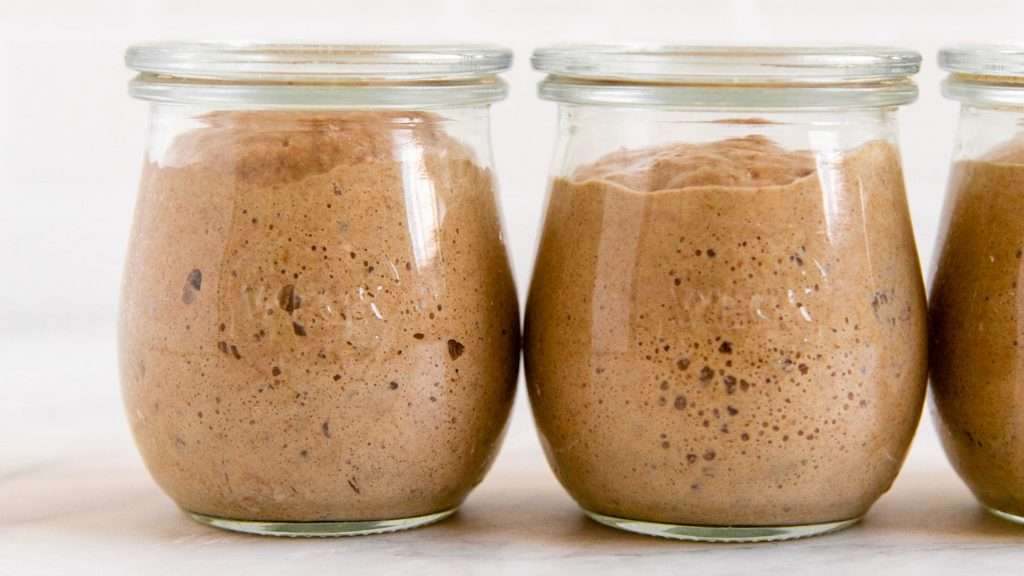
Feeding Ratio: How Much Starter to Feed?
Once your starter is bubbly and active, you only need a small amount to keep it going.
Here’s my general maintenance ratio:
- 10% starter
- 50% fresh flour
- 40% water
This ratio keeps the acid low and gives your microbes plenty of food without overpopulation. Too much starter (like a 1:1:1 ratio repeatedly) can cause fast acid buildup because the microbial load is much higher. For your starter to keep thriving, you want more food for fewer microbes, not less food for more microbes.
When Is My Starter “Ready” to Bake With?
There’s a lot of confusion about when a sourdough starter is officially “ready,” part of that is because the float test isn’t always reliable, especially for thin and runny starters.
A float test only works if your starter has enough structure (gluten) to trap gas bubbles and hold them in place. If your starter is too watery, even if it’s very active, it will just sink.
If you’re using quality flour and feeding consistently, most starters are microbially ready to bake within about seven days. As soon as bubbles form, feed it a little thicker and watch for signs of rise. The float test becomes a more useful tool once it’s thick enough to trap gas and visibly expand in the jar.
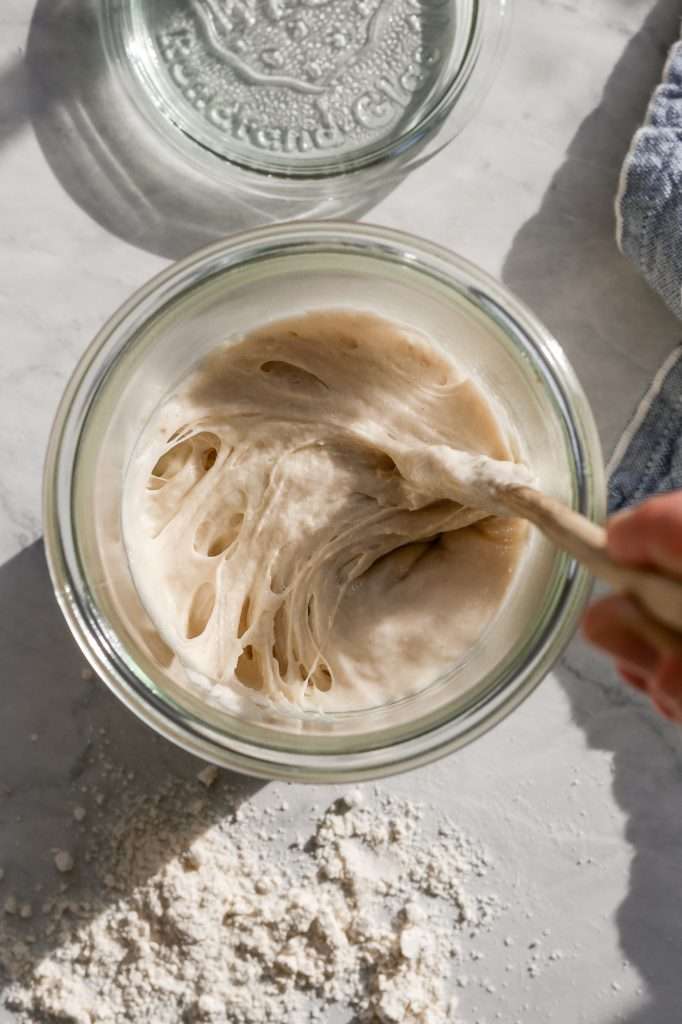
Why Isn’t My Starter Bubbling or Rising?
Starters not rising is the most common concern, especially during the first 7 days of establishing a starter. A few key things might be happening:
- It’s too early – The first 2–3 days are often quiet. Be patient.
- It’s just hydrated – Very wet starters will bubble but won’t hold a visible rise for long. Try thickening it slightly so you can see bubbles better.
- It’s not warm enough – Starters thrive around 75–80°F. Too cool, and they’ll slow down dramatically.
- You missed the peak. A well-fed, thinner starter rises and falls. If you check after it’s peaked, it may have risen but already collapsed. Thicker starters hold a rise in the jar longer so you can see it (and take a picture of it).
💡 Try this tip from my course: Feed your starter more flour or less water to make it thicker, or try a naturally more absorptive flour like sprouted rye. Once your starter is bubbly, you don’t need to measure it; give it an extra spoonful of flour if it’s thin.
What Does Sourdough Starter Smell Like?
A healthy starter smells pleasantly sour, like vinegar, yogurt, or beer. If it smells sharp or strange, here’s what might be going on:
- Nail polish remover or alcohol smell? Alcohol and acetaldehyde are byproducts of yeast fermentation, and they can make your starter smell like nail polish. It’s totally normal, but it’s a sign that your starter needs more oxygen. Stir, feed, and use a loose lid or cloth cover secured with a rubber band. Ensure it’s tight-weave cloth to keep bugs out.
- Funky or putrid odor? That could indicate poor flour quality or microbial imbalance. Switch to organic whole grain flour, stir more often, and ensure you feed consistently every 24 hours, then see what happens.

What’s That Liquid on Top of Sourdough Starter?
That liquid is called hooch; just alcohol yeast produces when your starter is hungry. You can pour it off or stir it in (though I usually pour it off for better flavor balance). It’s harmless, but it means your starter needs to be fed.
The colors of your starter and hooch will vary depending on the flour and microbe mix. Clear, gray, brown, or even purple hooch on top is normal.
Is That Mold?
Maybe. Maybe not. People often confuse dried-out patches or harmless pellicles (dried-out film on top) with mold.
If there is mold, it will look fuzzy and may be green, blue, black, or pink. If you see fuzzy mold or brightly colored growth, toss the starter and start fresh.
It’s always better to prevent mold than try to fix it after the fact. To prevent mold:
- Feed your starter every 24 hours.
- Use clean jars and utensils.
- Transfer to a clean jar every few days.
- Keep the lid clean; yes, cloth lids, too.
- Don’t let it dry out from neglect—especially around the edges. Keep it covered with a solid lid in the fridge, not a cloth lid.
What About Pink or Reddish Discoloration?
A reddish tint can be normal if you’re using 100% rye flour. But if you’re using white flour and see a pink hue, especially near the top or in the hooch, it could be a sign of Serratia marcescens, an unwanted bacteria. It’s best to start over.
Taking a Break from baking? Here’s What to Do
If you’re not baking for a while:
- Feed your starter.
- Let it sit out for 6–12 hours until bubbly.
- Seal with a lid and place in the fridge.
Feed once a week to maintain it—or even less frequently. I’ve revived starters that sat in the fridge untouched for two months. You should also dehydrate your starter for long-term storage and as a backup in case something happens.
How to Dehydrate Sourdough Starter (always to have backup)
- Feed your starter and let it peak.
- Spread a thin layer on parchment paper.
- Dry in a dehydrator at 98°F or until completely dry.
- Store in an airtight container.
To revive: rehydrate with water, feed daily as you would feed an active starter, and give it a few days to bounce back.
Advanced Troubleshooting Tips
If your starter seems sluggish, try one of these:
- Switch flours: Rye, spelt, and sprouted flours have more FODMAPs, encourage microbial diversity, and improve activity.
- Not sour? Add a drop of brine: A tiny spoonful of fermented vegetable brine (like sauerkraut) adds LAB to help balance the ecosystem.
- Bread not rising much? Add yeast: This is a controversial tip, but I’ve done it. Add some organic, natural dry, or instant yeast to balance out the yeast-to-bacteria ratio. And always remember to feed less starter, more flour + water when you discard and feed.
- Make it thicker: A thicker starter will rise more visibly and be easier to track.
- Warm it up: Use a bread proofer or place the jar in a warm spot.
- Add Sugar: A spoonful of honey or organic apple juice helps liven up a sluggish starter. Yeast loves fructose.
Final Thoughts: It’s Hard to Kill a Starter
Really. They’re resilient.
Things that won’t kill your starter:
- Stirring with a metal spoon
- Storing in the fridge
- Changing up the flour
- Forgetting a feeding once in a while.
Things that will kill it:
- Mold
- Neglecting it for days at room temp without feeding
- Using bleached or low-quality flour repeatedly.
As long as you keep feeding it high-quality flour, keep the jar clean, and stay curious, your sourdough starter will likely stay with you for life.

Sourdough Recipes to Try
- My Go-To Homemade Sourdough Pizza Crust Recipe
- Dutch Oven Sourdough Bread Recipe (Master Recipe)
- New York Style Sourdough Discard Bagels (Ready in 4 hours)


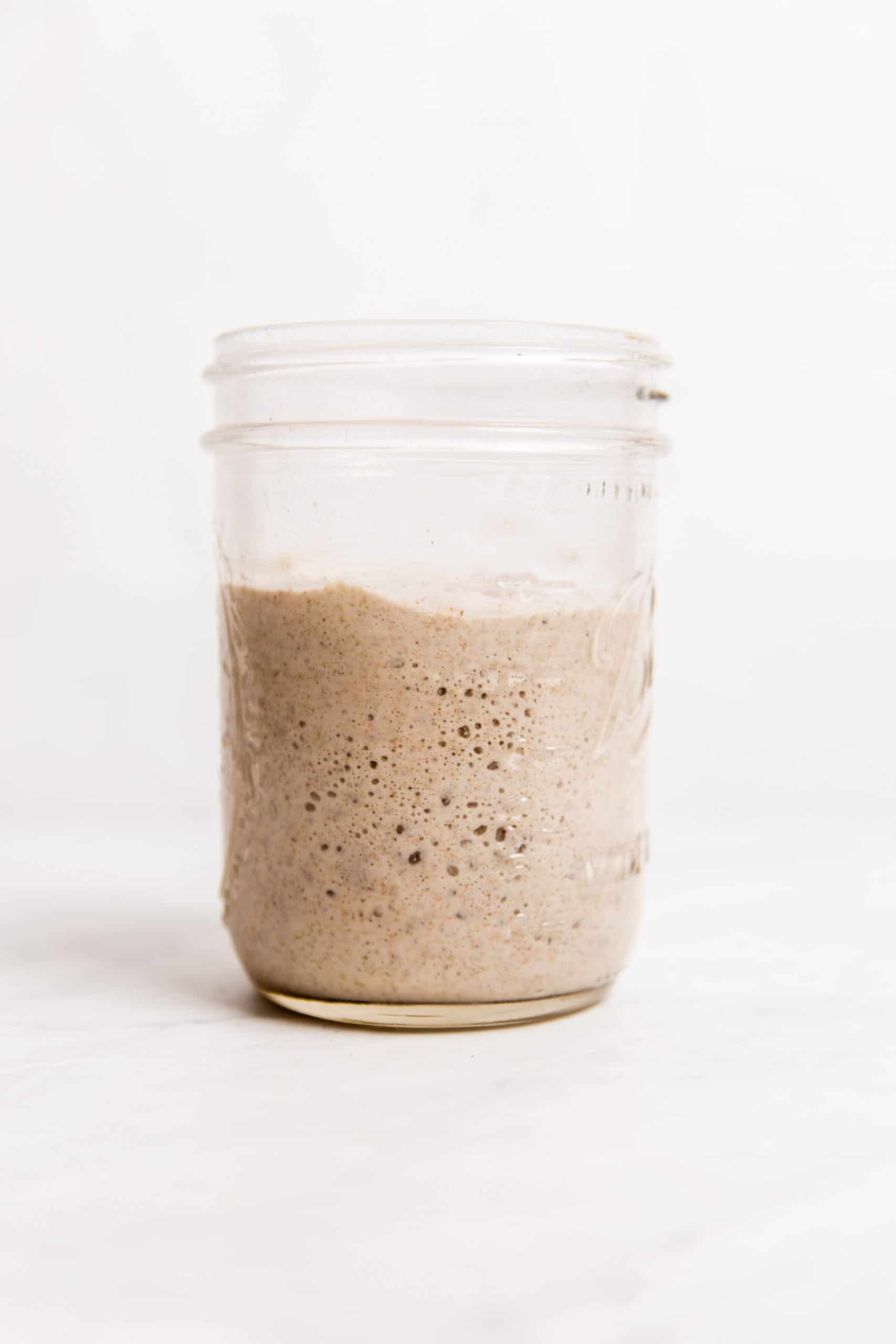


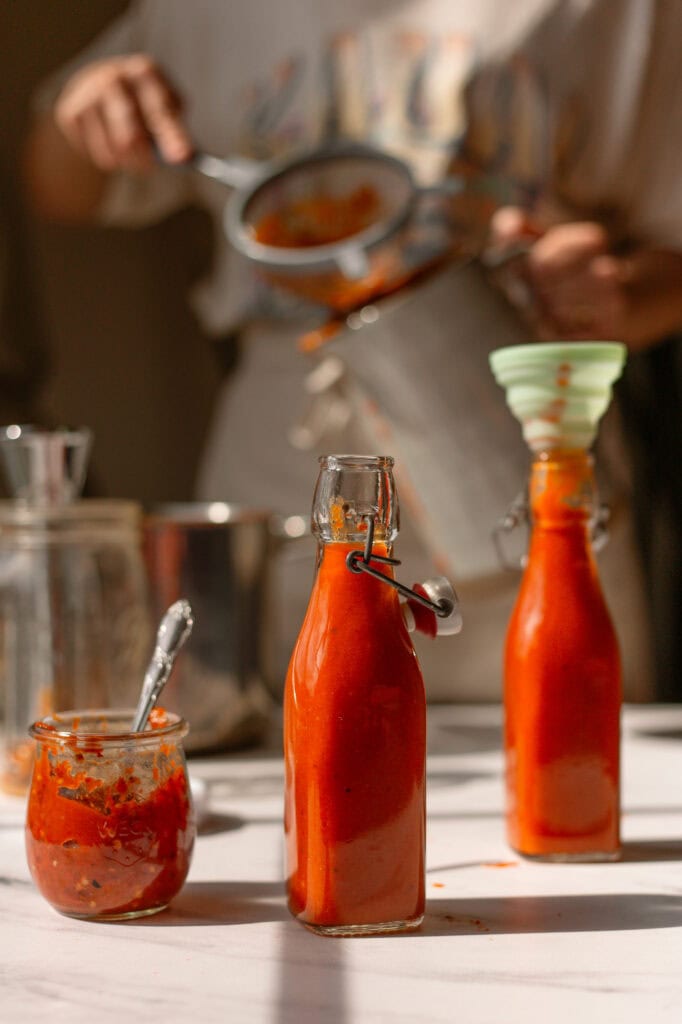








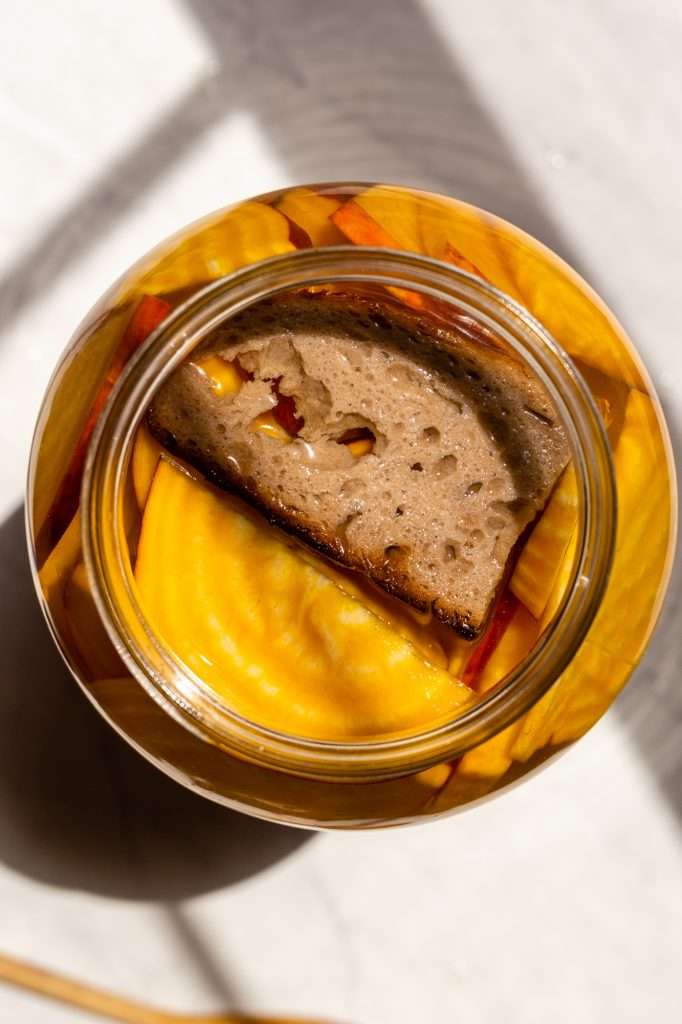
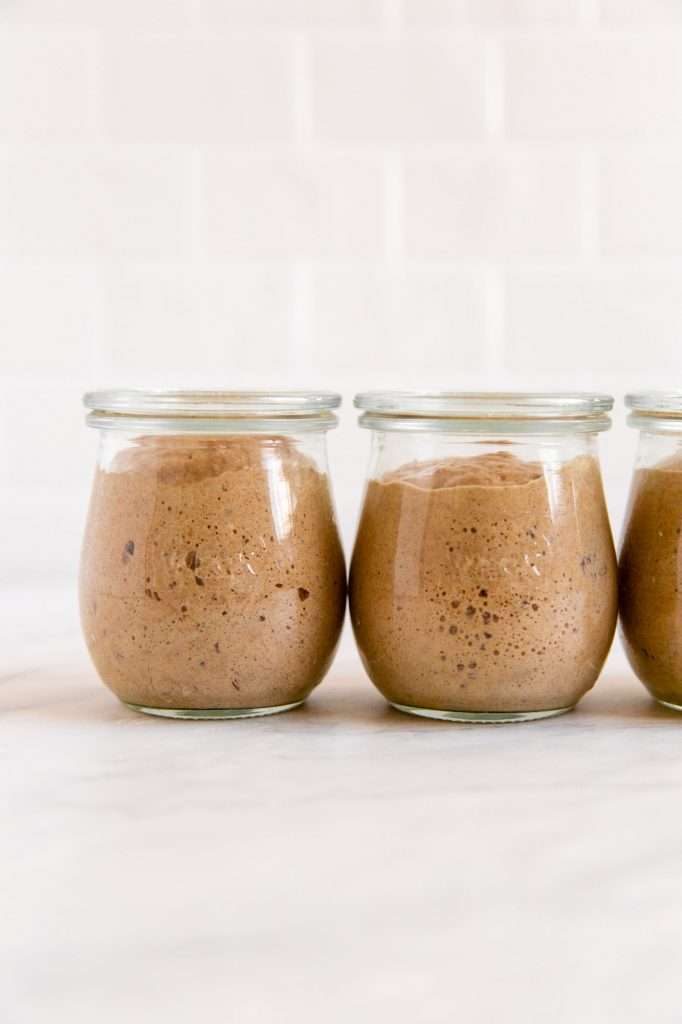


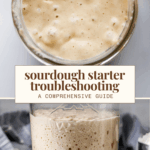
I used some of my active SD starter this morning to make a bread dough, and I fed it (after removing what was needed) with 1 cup water and 1 cup flour (didn’t weigh it). Realizing it might overflow container, I removed some of it to a second container. Nothing is happening after 8 hours in either container. Did I over feed it, since I had fed it yesterday too, for my bread today.
That’s a lot of flour and water. So, it’s likely that it just needs some time for the yeast to multiply and establish. Once they populate the mixture a little more you should see bubbles. If you want the starter to visibly rise, decrease the water amount next time for a thicker starter.
Hi! I have a question! One day my starter raised beautifully but when I came back at the end of the day to feed it, it had developed a thick skin and some gray hair/fur covering over the surface. I’ve already tossed it in the fear of mold. But do you maybe have any idea of what could have caused it? I’m using organic whole wheat flour and the starter was about a week old. I have some photos if it helps… It was just doing so well, I’m shocked mold grew!
Hi! You should read the section in this blog post under the heading “mold”.
Thanks for the article. Easy trouble shooting from such clear instructions.
I am adding 1 cup each of flour and water to my new) starter each day. It was very thick so I added a 1/8th of a cup extra water each day. It now has a watery layer on top. I see in the trouble shoot above that I should drain this liquid off with 3/4 of the starter and resume with less water.
My question is, can I use the liquid mixture that I drain off for bread making? It seems wasteful to tip it off and discard.
I have been using home ground wheat. I am not sure which type of wheat.
Thank you
Michelle
I wouldn’t suggest using the liquid layer on top for anything. It likely does not taste very good. It may have an alcohol/astringent flavor.
I accidentally added a half a teaspoon of Himalayan salt to my starter I was mixing a recipe put the salt in the wrong bowl. Very upset now, is it dead? Do I start over 🙁
It’s not dead! you can fix it!. Feed your starter with excess water: I’d feed it 50 grams of bread flour and 100 grams of water in a large jar. You’ll notice the water will separate to the top after 24 hours. Pour that off, then feed like normal. It’ll be fine.
Hi! Thanks for this post. So I’m on day 11 of my sour dough starter. It’s not doubling in size! I think because I’m in Canada it’s too cold? I tried everything to help fix it. I’m using filtered water, 1:1 ratio, a homemade proofing basket,…Today I tried all rye flour (previously used whole wheat bread flour) but after 5 hours it’s still not rising at all. Not sure what to do now and I just want to cry and give up 🙁
What sourdough starter recipe did you use?
Starters can take much longer than 5 hours to bubble up after feeding. When it’s cold here, I have to feed my starter and wait 12 to 24 hours for it to bubble up before using it in bread recipes. Since I feed my starter every single morning, it’s always bubbly and ready for use in bread recipes the next morning.
Don’t give up!
The starter recipe I have tells me to feed my starter with flour, milk, and a couple of pinches of sugar each time I use it. My starter is sweet now. Is there any way to fix it? Is there something I can feed the yeast with without using sugar? Thank you!
oh… interesting. I would never feed a sourdough starter milk or sugar. You can create and feed a sourdough starter with just flour and water.
My sourdough starter doubles in size when I feed it and has lots of bubbles but it does not float. It’s a little colder here in winter (Australia Brisbane) would this affect the floating ?
The temperature should not influence if it floats or not. What kind of flour are you using, and how hydrated is your starter? If your starter is very dense, it will rise and bubble, but not float. You can still use it to bake if there’s visible rise and activity.
That is the recipe for Amish Friendship bread, @FRIENDLYREAD1. As Kaitlyn says, sourdough starter is made with just flour and water.
My (1st) starter is the product of yeast water that took 13 days to bubble, but then smelled of alcohol, as it should. After using it to make 100% saturation starter, I have created gum. Virtually insoluble gum. Do I start over?
I don’t know what recipe, flour, or feeding methods you used to create your starter/”gum”, which makes troubleshooting difficult. so I’m going to say start over. Also, it shouldn’t smell like alcohol, it should smell pleasantly sour.
My starter looks like glue and smells like vinegar, can I bake with it? I use 50/50 flour to water ratio, started with wholewheat flour then fed with unbleached white flour. At first it smelled sweet and boozy, then it turned acetic as the weather got colder. It bubbles on the top but doesn’t have a sticky bubbly appearance like in the pictures, it doesn’t rise but is fermenting I think (produces a lot of gas). Should I start feeding it with wholemeal flour?
Sourdough starters should smell kind of like acetic acid (vinegar). That’s where the “sour” in sourdough comes from. I explain the microbial process of converting alcohol into acetic acid in this blog post, under the heading “acetone or nail polish smell”.
In the pictures here I do not use a 1:1 hydration. So, of course, yours looks different. I explain why your starter looks different under the heading “My Sourdough Starter isn’t Rising!”
If it’s bubbling and smells pleasantly sour, I think you can use it to bake!
Let me know if you have any more questions.
Hello
My starter has been in my fridge, untouched, for 7 months. I know, i know.
I took it out today and fed it. It my surprise, it’s bubbly, but has only risen about a half an inch. Should i continue to discard and feed to get it back to normal?
Yes! starters are really forgiving like that. I’d say discard and feed every day for a week, and then it should be back and ready for baking.
I had a starter hang out ignored in the back of the fridge for 3 years (no kidding) and went to ressurect it this week. I poured off the hooch, and fed it twice a day 50g starter to 100g flour and H2O and kept it in a warm place. For a few days it didn’t do anything at all but it’s now come back strong, esp after I started mixing in 30% whole wheat flour with the white.
There’s no sign of mold or other weirdness, so I’m hoping it’s good to go. Amazing what those yeasts can put up with and survive!
That’s wonderful! so glad it bounced back!
When people worry if their starters stored in the fridge for a while are dead… I think about how researchers cultured 5,000 year old starter from egyptian pottery found at an acheological dig site, and brought it back to life, then baked bread with it. They can survive quite a lot lol
I was feeding my starter a mix of 1/4 organic rye and 3/4 organic AP flour and it was fabulous. Then I switched to 1/2 organic whole wheat and 1/2 AP and literally nothing happened. I fed it twice with this mix and still nothing. I switched back to my original mix and the starter is doing great. Do you think the problem would be “dead” wheat flour? What could cause this? Thank you!
Interesting! I’d have to test the brand of whole wheat flour to know for sure what is going on. The microorganisms may just take longer to metabolize the whole wheat flour. Sometimes when you switch to a more dense flour, like whole wheat, it can take 24 hours or so for your starter to show activity.
My sourdough gets like a layer of light purple dough.. I don’t know if I should start over or take out the purple dought from top and feed it again. I already did it once and the purple came back. I used buckwheat flour and water.
It’s probably because you used buckwheat flour. This type of flour can sometimes cause purple-ish hues. Try using a fresh, clean jar and a different type of flour.
Wondering if you had any thoughts on this situation. I gave my sister-in-law some of my sourdough starter and she said it went bad really fast and it didn’t bubble. I keep mine in the fridge and feed it once a week. And this time it had a lot of hooch like three times as much as normal. I’ve had this sourdough starter for over a year. Do you know why it would be doing this?
I’d love to help, but I’d have to know more specifics on what she means by “it went bad” to help any further with that.
As for yours, sourdough starter microbial communities can change over time especially at cold temperatures. I’d suggest feeding it every day at room temperature for a week, then you can resume the fridge storage/feeds. This helps balance out the ratio of yeast to bacteria in the starter, which should fix your hooch problem.
Do you know about brown rice sourdough starter? Mine has turned a bit reddish. It doesn’t smell bad. Not sure if I should throw it out and start over.
It’s hard to tell you since I cannot see it or smell it. If it’s a dull very light reddish color, it’s probably just from the color of the brown rice changing through fermentation. If it seems more like a bright red or pink, it could be from a contaminant like Serratia.
Make another brown rice starter in a separate, very clean, sterilized jar. Use boiled water that has cooled, and see if the same color develops. If it does, that’s just the natural color. If it doesn’t, then it turned reddish from cross-contamination bacteria.
Hi Kaitlynn,
My rye sourdough starter (made from equal weights of flour and water) looks good and very active after 4 or 5 days of feeding. When I take off the top of the jar it initially has a not unpleasant fruity aroma, however when I break the surface and mix it up it produces a putrid, metallic smell that is not at all pleasant and smells definitely wrong! I have had the same result with my last few batches of starter and as far as I can work out I’m doing everything right. The only thing I can think of is that I’m not controlling the temperature properly by not keeping it at a constant warm around 25C (77F)?
Have you got any ideas why my starter is smelling like this? Many thanks, Ross D
What kind of top are you using on the jar? and what recipe are you using? I do not suggest equal weights flour and water. We have a recipe for rye starter I suggest following.
Thanks for this article, I’m just trying to figure out what went wrong so it doesn’t happen again. I’m guessing just that my jar or spoon wasn’t clean enough? I made my starter 7-8 months ago, I’ve had times of being really consistent with it and times of not so much. But it’s been warmer in the house now and it seemed like it was deflating sooner, so I feed it sometimes in the morning along with the night feeding, this morning I did not feed it and tonight (~24 since last feeding) and it had a slight fuzz over the surface same color to maybe a slight gray color. had a slight nail polish remover smell but not more than when it’s been a little hungry before. I followed the instructions under the “mold” section. I just trying to figure out the best way for it to not happen again! It has been dry on the top lately when I feed it but otherwise has been working wonderfully for me, even just this morning it looked like it was double-triple it’s size. (Whole red wheat flour, 100%hydration, measuring by grams)
Oh I don’t know if this would have anything to do but I had it a bit closer to my kombucha and had started 3 gallons vs one as of last week. That’s the only other thing that has changed.
Hey there,
It shouldn’t have anything to do with the kombucha. What kind of lid are you using? The nail polish smell is an indication that it is not getting enough oxygen.
If your starter is more on the dry side, a dry crust with a pellicle can form on the surface. To me, it sounds like that’s what you are describing.
I keep it in a wide mouth mason jar with a coffee filter and just the ring holding it in place, gnats are pretty bd in our house right now so I’d be afraid to use a cheese cloth, would you recommend a fabric cover of some kind or something else to cover it?
A coffee filter should work fine, but I’ve never used one as a cover. I personally like to use old t-shirt pieces as covers.
Hi! So I have a recipe for a basic buckwheat sourdough bread from a health food book I’ve made and enjoyed a couple times. This time I let it sit for 24 hours instead of twelve and the sour smell changed to more of a garbage smell…I didn’t notice discoloration and it rose more than usual. Do you think it is safe? I’m baking it now 😅
Hi there! Buckwheat flour does not ferment the same as wheat flour. I cannot tell you if a recipe that I have not seen, that was written by someone else, is safe or not. A “garbage” smell sounds quite unappetizing, so eat at your own risk.
I dried my sour dough starter. What is the best way to bring it back?
Just add the dried starter to some fresh water and flour and feed every 24 hours as normal. You can use our sourdough starter recipe for feeding instructions.
Hi! I was given some sourdough starter from a friend and it has some ooey, clear mucus like bits floating in the starter. Is this normal? I’ve never seen it before. It’s wheat flour based, was kept in the fridge with cheesecloth over top. The bits remind me of scoby. I’ve just fed it for the first time today and hope it will rise.
I think someone else commented here about something similar. It’s possible that this is normal since sourdough starters do have the same types of acetic acid bacteria that build kombucha scobys… however, I’ve never seen it happen before. I’d say just keep discarding and feeding and see what happens.
Thanks Kaitlynn! Very helpful post. I’m trying to make a spelt flour sourdough starter (can’t digest wheat or rye) and have had several flops in which it would develop fast on day 2 and then nothing further (kept trying for about a week of daily feeds before starting over). This time I’ve used a half tsp of organic honey with each feed (read elsewhere the sugar can help it develop) and it does seem to bubble up, but only within a small, 1 inch top layer; the 3-4 inches of starter underneath has zero bubbles in it. Same thing every day. Of course i stir it thoroughly and make sure there is no solid deposit of overly thick matter at the bottom. Do you have an idea how to get it to “start” throughout? This 1 inch bubbly layer on top is not enough to bake a loaf of bread
You can try our gluten free sourdough starter here: How to Make a Gluten-Free Sourdough Starter From Scratch
I was given a starter more than 15yrs ago and I was beginning to think I was somewhat proficient, as my loaves were tender/tasty. The starter suddenly got weird, with recent loaves looking beautiful when I take them out of the oven, but there’s a giant pocket under the top crust; then it collapses into adding a dense rubbery loaf. I started a clean jar with a 1/2C w/w Lindsey mill bread flour and a 1/3C spring water. When I added a tablespoon of my starter, I could hardly stir it, as I now had a rubbery mass. I’m ready to start anew, but perplexed about how this happened after so many years of success. (I have some original starter in the freezer. Dare I use it?) Thx!
This sounds like an issue with the water ratio in the bread recipe and an issue shaping the loaf, not an issue with the starter. Are you stretching and folding the dough enough while it rises? and doing a pre-shape plus a final shaping?
Have you worked with quality bread flour before? It has a much higher gluten content.
Hi, my starter always forms like an actual scoby on top. If I dont feed it for a week, it gets about half inch thick. It is a neutral color and not dark or smelly. I usually throw it away, but was wondering if my sourdough is a hybrid of kombucha and sourdough, like a new species. I’ve been using the same starter for 7 years. It makes fine sourdough bread. Is this common? Thanks
Wow! That sounds very interesting! I’ve never seen this before, but it is very possible.
Sourdough is a mix of wild yeast, acetic acid-producing bacteria, and lactic acid bacteria. In Kombucha, acetic acid-producing bacteria (AAB) are the main type of bacteria in SCOBYs. AAB are the microorganisms in the SCOBY community that produce cellulose to build the SCOBY structure.
If your starter has a high population of AAB, that would explain the SCOBY-like structure forming. I’m unsure if it is common, but I’m not surprised that it happened.
Hi! I found this post looking for some troubleshooting for my starter. I’ve had mine for years, make bread all the time. But one day forgot to put it in the fridge and left it in the kitchen counter for three days. When I opened it noticed the parmesan smell and also noticed that the surface of it looked oddly velvety (as opposed to shiny that I always see). Discarded almost all, grabbed new container and reanimated with several feeds every 12 hours. Now is strong and healthy BUT still has the weird velvety surface. I’m afraid some bacteria got in it or something? Do you have any idea of what could it be?
Sounds like a bloom of yeasts on the surface! This happens to mine sometimes too. The cheesy smell indicates it may be a yeast, like Geotrichum candidum, which forms velvety growth and is used to ripen certain types of soft cheeses. If you want it to go away, you can try increasing the hydration of your starter just a bit.
I will! Thank you for taking the time to respond!!! Much appreciated.
I assume is just fine cause it springs strongly but I will try what you recommend.
Forgot to say…thank you in advance!!! 😌
Thank you for all your help. I stumbled on your web page when trying to find a cure for my starter. and you saved me. My bread now has spring and that great sourdough flavor.
oh wonderful!! I’m so happy that I could help save your starter!
My sourdough is probably not fed as often as it should be but I always feed a day before baking. My question is why does my dough not rise? Is it because the starter is not good?
Does your starter rise when you feed it? Does it bubble up before you use it in the bread recipe? Dough not rising could be due to a multitude of factors. Are you using one of our bread recipes?
I have a great starter but neglected it for about 6 weeks. I worry that it turned pink but don’t remember. It smelled awful when I started to revive it. I have feed it every couple of days for about 2 weeks. it looks great and bubbly but still smells weird and strong. Not like it used to. Have I killed it or has bacteria destroyed my lovely starter?
Did you neglect it at room temperature or in the fridge? If you don’t have a problem with packaged yeast, you can add a teaspoon of packaged yeast to your starter to rebalance the yeast to bacteria ratio. Then keep on discarding and feeding daily like normal.
I have a starter from fridge took out fed it in the morning I wanted to knead it didn’t rise
It can take a while to bring a starter back to life after storing it in the fridge. Keep feeding and discarding every 24 hours and see what happens.
I am trying my second go-round making sourdough bread. I’m using bread flour. The starter is bubbly, but after I create my leaven, the next morning, there’s lots of moisture in the plastic wrap and the surface of the leaven is dry with no bubbles. What do I need to change?
how are you making the leaven? are you weighing the flour and water to measure? When using bread flour, you should use about equal parts (measuring in mass) flour and water.
I started a new batch of teff gf sourdough starter over the holidays and I noticed about a week ago that I have a purplish hue on top where the starter is exposed to air. The purple color is slowly expanding to discolor more of the starter. Is it going bad or just oxidation of the teff?
When I started it, I used a purple cabbage leaf and apple peel to get it going. I removed the cabbage and apple peel after 48 hrs and continued to feed every day for 10 days. Then I started refrigerating it and fed it every other day. Today marks 4 days of the starter in the fridge without feeding (the first time it’s been 4 days since the last feeding). The starter smells good but I am concerned about the color change. There is no liquid (hooch) buildup on top. Thank you for your insights in advance!
If you used a purple cabbage leaf… then that’s probably why it’s purple. I’ve never worked with teff, but it also has a natural reddish purple hue.
Hello, i like your info and replys to people with starter problems , i am a beginner too and would like to make rye bread from sourdough ! I liked a video from a German lady so i am doing what was recommenced .
Last Friday a started with 50gr. of Rye Flour +50 gr of water (tapwater boiled 5 mins) and cooled to 90 degs.
Next day i added 50gr. of Flour and 50 gr. of water ,mixed and sat in a warm place ! The next day i added 100grs. of flour and 100grs. of water ,mixed well and some time later noticed it rising almost double , thought i was going to put in a larger jar ! but it settled down . It never recovered again even after i fed the mixture (3) times at intervals of 12 hours ! I do see tiny bubbles and it has a nice smell but i thought it would start again to rise after each feeding . then in 6or 7 days have a starter for bread making ! Sorry for the long question , Any suggestions , Jerry Uhte Thank You !
Sorry for the long question , any suggestions ? Thank You, Jerry Uhte
If you are using rye flour it might not have enough water. When I use rye flour, it’s a sprouted flour and it requires more water than a 1:1 ratio. I use 1:2 (flour to water) for my rye starter. Also, it sounds like you are not discarding… After the first feeding you need to discard before you feed it. For my rye starter I take 50 grams of the established starter, put it in a fresh jar and add 50 grams of flour and 100 grams water.
You also might be missing the rise? are you sure its not just rising and falling back down while you are not looking at it?
Hi, there! Thank you for your info it’s very helpful I have a question about mold. Im a beginner and I’ve been doing my starter for a few weeks, I’m using spelt flour. I used a jar that was too big so the sides have developed a crust on them and they have black spots. The starter seems fine but I’m worried that the black spots are mold. It doesn’t seem fuzzy really so I’m not sure. Should I throw it all away and start over or just move my starter to a clean jar?
If you have some fresh starter in the bottom of the jar, you can just carefully spoon a bit out and feed it in a clean jar.
Thanks for all your wonderful information! Are you familiar with Dr Stephen R Gundry’s “Plant Paradox” eating plan? It eliminates many grains that are problematic. Almond, Coconut, Sorghum, Cassava, & other flours are compliant. Have you tried sourdough with these flours?
hi there! I’ve heard of it, but I do not think fermented wheat is bad. Long, naturally fermented wheat is not a problematic grain. I have a recipe for gluten free sourdough starter linked above if you’re interested.
Hello. I am just beginning a sourdough starter. I have tried twice with 50 g water and bread flour but each morning it had slight pink/purple spots just after the first day. I’m not sure what I am doing wrong. I used Bob’s Red Mill bread flour and bottled water the first time and filtered tap water the second time. Both times I had it in a plastic food storage container with a plastic lid. I am trying again with a mason jar and cloth cover. Do you think I need to feed it again after 12 hours?
It sounds like you were using a solid plastic lid… that and the plastic container were most likely the cause of your problems. Sourdough starters require oxygen, and should always be kept in a glass jar with a cloth covering. I bet you will have better results after switching. You only need to discard and feed the starter once every 24 hours.
Hello, o have used the same starter for over 2 years, and today when I went to feed it, there is definitely mold on the side of the jar. There isn’t any in the starter itself, but I’m not sure what to do in this instance. Do I need to throw the whole thing out? I poured the starter out using the opposite side from the mold so it didn’t come into contact with it, into a new jar, but I’m a little afraid of the mold lol. Is it still ok to use?
sounds like you did fine fixing it! It should still be okay to use as long as it was not black or colorful mold. I suggest putting your starter into a clean jar every other day.
Hello! Thank you for all the great information. I found your article because my starter (all purpose 1:1, smells like alcohol, and cover with paper towel and rubber band) had a dried out top that had bubbles, about a centimeter, but the mixture on the bottom was liquid and lighter in color with no bubbles. There wasn’t any discolored streaks or fuzz but the top was like one shade darker. Is this oxidation? Or the beginning of mold?
Thank you for your help!
Yes the top can dry out after 24 hours of no feeding. Sounds like you just need to remove the dry top, discard and feed it. Most starters are ready to use, 4-6 hours after feeding. When you leave it 24 hours, it can rise, fall then dry out on the top.
Hi! I have begun a starter with organic all purpose flour, but I would MUCH rather use a sprouted rye like you mentioned. Do I need to start over, or can I just begin feeding with the sprouted rye: H2O, 2:1 mixture that you recommended?
you can just switch your starter over to rye flour, no need to start over.
Hi! I was wondering what causes the red hue in the starter when using a 100% rye flour?
Hello! Rye flour is usually light brown to very dark brown. Red is one of the primary colors that make brown. So pigments in the rye flour can make it take on a light reddish tinge when it ferments.
Yesterday I noticed white fuzz near top of sourdough starter jar. Also, looked like some green on side of jar where some starter had stuck. There was nothing on starter itself. I took small bit of starter and put into a new clean jar. So far not seeing any mold. Is this okay or do I need to start over? If it has mold will it quickly show up again?
Great tips. Still need your expertise, I have a starter that has a hard crust on the top. Underneath it looks alive and when I feed it it keeps doing its bubbling thing but what is the hard crust and should I just throw it away ?
That’s normal. No need to throw it. It happens when the top dries out.
Hi Kaitlyn! I’m on day 12 with my new starter and yesterday i skipped a feeding based on tips i found on tiktok. after about 48hrs since feeding, it had doubled and was already almost all the way back down. However, i noticed it was developing some faint white spots on the surface. not fuzzy, kind of like a thin film. is that mold? i discarded and fed like normal, but worried hahah. If it was mold, and there’s still mold in it, will i know? Will it become visible or affect how it’s rising? Is there a chance it goes undetected?
It probably wasn’t mold! Just keep feeding and discarding like normal and it should be fine.
I accidentally doubled my flour to feed a new starter . What should I do ?
Just roll with it. Add a little water to make it thinner if you cant stir it, and then keep feeding as normal.
My starter smells and looks really good! Everything was going according to plan until I baked the bread and it came out purple… I aww what you advised about Hooch, but my starter looks fine…
That’s weird. what bread recipe did you use and what kind of flour?
Hi I need help! My sourdough starter looks great and rises pretty well but about a month ago it stopped falling. It is about a year old, I feed it once a day. The temperature has warmed up here some in the past month. I can’t think of any other factor that has changed. Thoughts?
Thank you
So It just rises up and then holds the rise? That’s not a bad thing! It just means your starter is super thick. Have you started using a more absorptive flour recently, like whole wheat or rye? You can make it thinner by adding a high ratio of water.
Hello! I recent bought a large bag of King Arthur Unbleached Bread flour, and have tried to start a SD starter with it with no success, and it’s been almost a week. No matter how often I feed it there is a small amount of clear liquid of the top after just a few hrs. And it becomes very slimy and it smells rank. Any advice?
If it’s conventional (not organic), it’s probably “dead flour”
It probably doesn’t contain the good microbes necessary to establish a starter. I suggest trying organic flour or you can use a sourdough starter culture to get it going.
I used distilled water with cultured starter. Oops. Can I continue with well water when I feed?
If it’s tested and safe well water, sure, filtered well water should work fine.
Hello, enjoyed your article. I’m a newbie, I started on Friday and Saturday my starter barely rose, so I left it till the evening and went ahead and added more flour/water, covered with cloth, then left it overnight. Sunday morning it had risen with bubbles, looked great and had a sour smell. 2 questions: Is it normal to already have the sour smell, I thought it was suppose to take like 7 or more days? Also, Sunday afternoon I noticed liquid in the bottom of my jar, not on the top, is this hooch or something else? Thank you for your time and your insight!